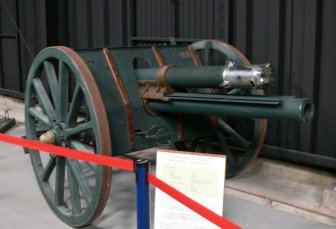
ARTILLERY REGISTER |
|||||||||||||||||||||||||
|
|
||||||||||||||||||||||||
| Historical Specifics: | The 18 pounder gun was introduced into Australian service in 1906 and continued to be used until 1945. It was the standard field gun in service until 1940 when it began to be replaced by the 25 pounder gun. It was the first gun used by Australian field artillery to incorporate a hydro-pneumatic recoil system and interrupted thread, single motion breech mechanism. These allowed for a vastly improved rate of fire to the 15 pounder BL that it replaced.
Problems with the recoil system became evident early during the war due to the amount of firing undertaken by the guns. This was resolved in 1916. Several changes were made to the gun over its life. Apart from the recoil problem already mentioned, the carriage was of the pole type. Designed to reduce weight it also restricted the elevation of the barrel, thus restricting the range. Later split and box trails were introduced. There were 116 18-pounder guns in Australia when World War I commenced and many of these were sent to Gallipoli and France during the war. In addition further guns were purchased to replace damaged guns and also to supply the increasing number of gun batteries in the AIF. It is estimated some 500 guns were obtained in all. The major problem with the 18 pounder in providing supporting fire at Gallipoli was its limited elevation meaning it fired on a relatively flat trajectory. This limited its ability to engage targets in the hilly conditions found on the Peninsula. Another problem was the lack of high explosive ammunition available. The 18 pounders were seen as a field gun to be used against troops in the open and therefore it was issued with shrapnel shells. However, these were of little use against troops that were dug in or against defence works. In 1939 a number of the guns were converted to take pneumatic tyres which allowed them to be towed by vehicles. The 18 pounders saw service in Gallipoli and the Western Front in France during World War I and in the Middle East, Malaya and New Guinea and the defence of Australia in World War II. They were withdrawn from service in 1945. A number were used as funeral guns up until the 1980s. 18 pounders are very rare in Australia. |
||||||||||||||||||||||||
| General Information on Gun Type: | |||||||||||||||||||||||||
| Additional Photos: | |||||||||||||||||||||||||
